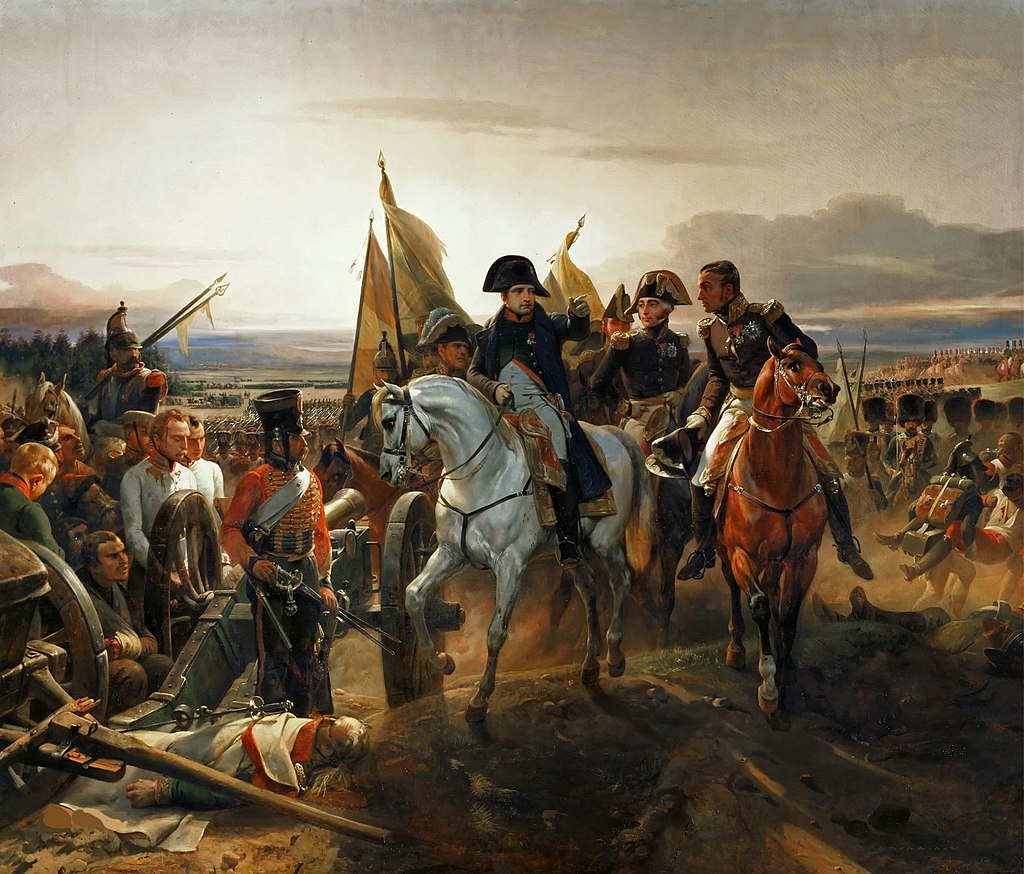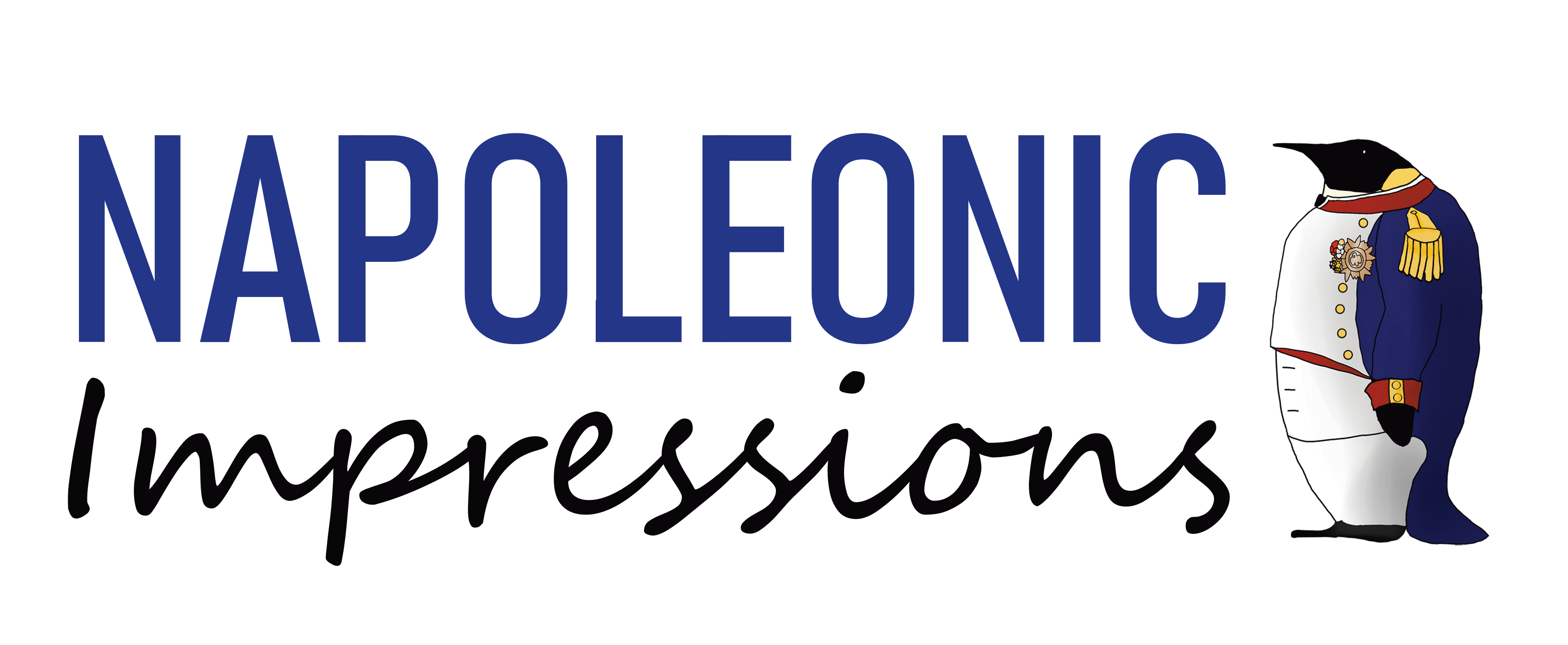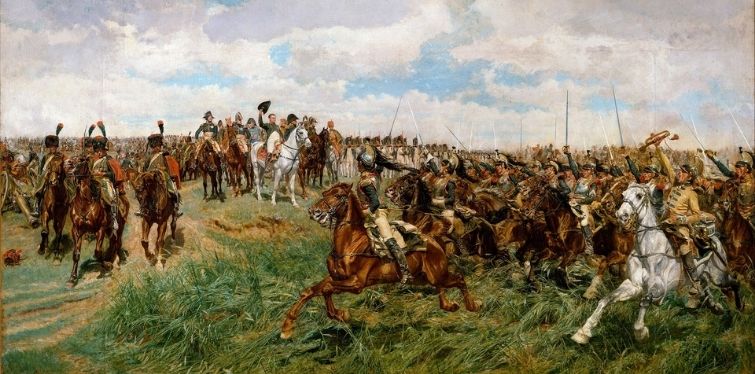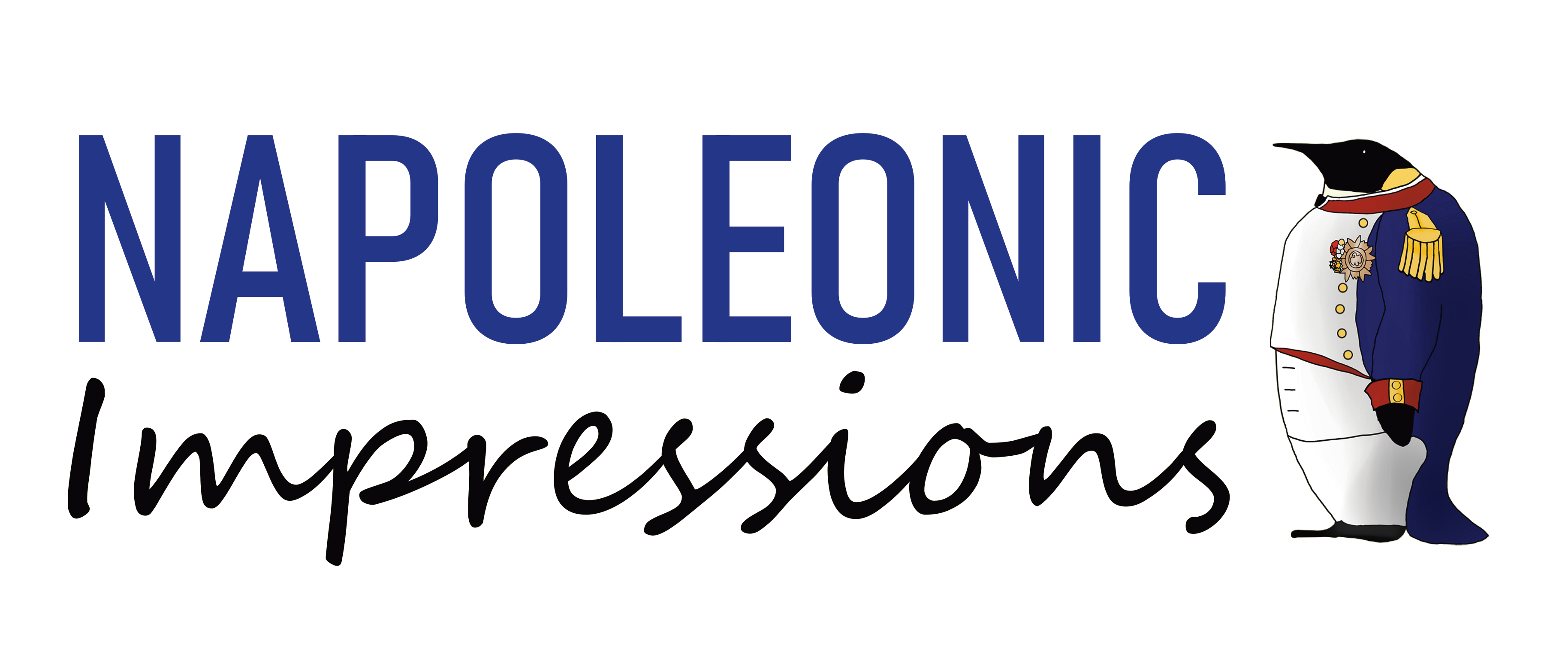This post is the third in a five part series looking at some of Napoleon’s greatest battles. For other blog posts in this series, click here. Like Austerlitz two years earlier, the Battle of Friedland in June 1807 was a fine demonstration of Napoleon’s ability to realise when his enemy was trapped, and to take full advantage. The battle was also the culmination of more than two years of warfare which saw Napoleon sweep aside his continental European rivals.
Following the humbling of the Austrian and Russian armies in 1805, Napoleon spent much of 1806 in a diplomatic stand-off with Prussia, which had remained neutral but was increasingly agitated the expansion of French influence in Germany. With his ministers divided between making peace with France or going to war, King Frederick William III eventually opted for war. Like Austria the previous year, the Prussians were confident of success that they advanced without their Russian allies. As with the Austrians in 1805 (who at least had the benefit of the doubt), such confidence would prove to be misplaced.
On 7 October, Napoleon received an ultimatum from Prussia to evacuate Germany. This was effectively a declaration of war, and Napoleon marched against Prussia with an army of 180,000 men. A week later, on 14 October, the Prussians were decisively defeated at the battles of Jena and Auerstedt in Saxony. Napoleon, with his main force at Jena, had won a relatively easy engagement against a smaller Prussian force under the Prince von Hohenlohe.
At Auerstedt, Marshal Davout, with his formidable III Corps of some 26,000 men, managed to defeat the main Prussian army of 65,000 under the Duke of Brunswick. The Prussian soldiers did not lack in courage, but were let down by poor command. Napoleon could never have imagined that Davout would have stumbled on Brunswick’s main force, and was astounded to hear that Davout had not only survived, but secured victory. It was truly one of the most remarkable episodes in the Napoleonic Wars, but Napoleon himself had very little to do with it. Over the following weeks the broken Prussian units were rounded up and surrendered. After he arrived in Berlin, Napoleon issued the Berlin Decree on 21 November, which aimed to prevent the British from trading with continental European ports.
Meanwhile, despite the calamity of Jena-Auerstedt and the loss of his capital, King Frederick William did not come to terms but retreated eastwards with the rump of his army (15,000 men under the command of General Anton Wilhelm von L’Estocq). Frederick William set up his court-in-exile in the old Prussian capital of Königsberg, in close proximity to his Russian allies. The Russian army was initially under the command of Count Mikhail Kamensky, a 68 year old veteran of the Turkish Wars. The elderly Kamensky was not in a fit state for command and he soon left the army. His place was taken by Levin August von Bennigsen, a German in Russian service who was well-regarded by Tsar Alexander. Over the course of the winter of 1806-07, Bennigsen and Napoleon danced around East Prussia and Poland, each attempting to outmanoeuvre the other. In the minor clashes that had taken place, the Russian soldiers proved themselves the equal to the French.

Levin August von Bennigsen
The first major clash between the Russians and Prussians took place at Eylau on 7-8 February 1807. In January Bennigsen had launched a promising offensive against Napoleon, forcing back Ney and Bernadotte. In response, Napoleon conceived of a counteroffensive to cut Bennigsen’s communications towards Russia. Fortunately for the Russians, Cossacks managed to capture a copy of Napoleon’s orders to launch a counteroffensive, prompting the Russians to fall back on the village of Preussisch Eylau in East Prussia, some 40km to the south of Königsberg. Bennigsen managed to concentrate 65,000 men and sent orders to L’Estocq to hurry to his aid with 9,000 men.
The ensuing battle proved a bloody slaughter. Napoleon sent Soult and Augureau’s corps forward to pin Bennigsen down, while Davout and Ney’s corps – not yet on the field – would arrive to strike at the flanks. Blinded by a snowstorm, Augereau’s corps blundered into the path of the Russian guns and was decimated. Bennigsen then attacked in the centre, breaking through to Napoleon’s entourage. The Emperor was desperate and turned to Murat, who launched one of the most spectacular cavalry charges of the age, breaking through the Russian lines and sabring the artillerymen. The desperate charge gave Napoleon time to consolidate, and for Ney and Davout to arrive. Although Davout’s corps managed to push back the Russian left, threatening to fold the Russian line back on itself. Bennigsen was saved by the timely arrival of L’Estocq’s Prussians which attacked Davout’s flank. Ney’s arrival in the evening saved Napoleon from defeat. Bennigsen, realising he had no fresh reserves to call on, withdrew from Eylau in good order.

Napoleon on the Battlefield at Eylau, Antoine-Jean Gros
The French claimed a tactical victory, but at great cost – up to 10,000 dead and even more wounded. Bennigsen had managed to slip away and fight another day. The terrible slaughter was a shock to the Emperor. This was not the decisive victory he desired and had been used to winning. For the first time, he had come up against an enemy army which not only fought bravely but – at least for the time being – was competently led. Napoleon knew from reports from Paris that France was getting sick of his wars. But the war would continue, and Napoleon would have to wait for the opportunity to defeat Bennigsen and force Tsar Alexander to the negotiating table.
The heavy losses at Eylau prompted Napoleon to return to Poland to rebuild his army. By June 1807, after calling up conscripts from the class of 1807, Napoleon had an army of 220,000 men. Bennigsen had half that number but the Russians were also building up reserves in the rear. He had taken a strong position at Heilsberg which Napoleon failed to take in a battle on 10 June. Though the attempt was in vain, Napoleon realised he could simply outflank Bennigsen by targeting his communications with Königsberg, which prompted the Russian general to fall back.
Lannes’ V Corps, in the capacity of the advance guard, located the Russians at Friedland, around 30km to the east of Eylau. Bennigsen, correctly assuming Lannes was isolated, intended to defeat his corps before continuing his retreat on to Königsberg. However, in order to advance against Lannes Bennigsen would have to cross to the western bank of the River Alle with only a handful of bridges to serve as his lines of retreat. Although he only had 25,000 men, Lannes saw the opportunity to entice Bennigsen forward and trap him in a bottleneck, sending word to Napoleon to hurry to his aid with three corps. Bennigsen fell into the trap, taking the morning of 14 June to mass his troops across the Alle so he could deal with Lannes in force. This gave Napoleon the time to arrive on the field together with Victor’s (Bernadotte had been ill) I Corps, Mortier’s VIII Corps, and Ney’s VI Corps.

Marshal Jean Lannes
Over several hours the French massed their artillery to target Bennigsen’s men in the bottleneck across the Alle. The general expectation in the French army was to wait to attack on the following day. Napoleon decided otherwise, fearing that Bennigsen would once again slip away from his grasp as he had done so before. Moreover, it was an auspicious date – the seventh anniversary of his defeat-turned-victory at the Battle of Marengo. He sent General Oudinot’s formidable Grenadiers of the Guard to support Lannes, while ordering Ney to attack Bennigsen’s left flank which was still in the process of forming up. The Russians were surprised by the attack and the Russian left fell into disorder, but a timely charge by Russian cavalry blunted Ney’s momentum.

Napoleon at the Battle of Friedland, Horace Vernet
Napoleon then brought Victor forward to support Lannes and ordered a cavalry charge, attempting to force Bennigsen back and prevent him from being able to deploy on open ground. The confusion in the Russian lines allowed Victor to slowly advance an artillery battery of 30 guns under the cover of light infantry. Safe from being charged, Victor’s guns targeted their fire into the masses of Russian infantry, causing terrible carnage and exacting revenge for the Russian artillery’s destruction of Augereau’s corps at Eylau. The Russians fought desperately and bravely, as they always did, but the ground did them no favours. Although Bennigsen attempted to attack the French right, Mortier and Lannes held on, with some support from reserves from the Guard.

The fury that Victor’s guns had unleashed on the Russian centre allowed Ney to continue his advance on the Russian left. Bennigsen was forced to call on the Guard to resist Ney, but even the cream of the Russian infantry could not hold against Ney’s corps. The Russians tried to withdraw and attempted to delay the French by setting fires, but the wind blew against them and burned the bridges that had served as the lines of retreat. Many Russians drowned in the river in their attempts to escape. Further to the north, Lannes, Victor and Mortier now advanced together against Bennigsen’s battered lines. Only through the fortuitous discovery of a ford over the Alle did Bennigsen manage to extricate the bulk of his army in good order at around 11 at night. Even so, Napoleon had finally managed to accomplish what he had failed to do at Eylau, and inflicted a decisive defeat on the Russian army, which lost 20,000 men or a third of its force. French losses were around half the number.
In the days following the battle, Murat’s cavalry, which had not taken part in the battle and was still fresh, embarked on a determined pursuit of the Russian army. Bennigsen was cut off from Königsberg, which was captured by Soult, and the Prussians were effectively out of the war. Bennigsen had fought an effective and competent campaign and successfully eluded Napoleon for six months, often with a smaller force. Nevertheless, he had allowed himself to be baited by Lannes and to place his army in an extremely vulnerable position, even though his main strategic aim was to fall back on Königsberg, and he must have been aware that Napoleon could not have been far behind. Lannes proved Davout’s equal in his use of terrain to defend against a numerically superior enemy. Victor’s use of his artillery also demonstrated the Grande Armée’s tactical innovations had not yet been fully appreciated by Napoleon’s enemies. Impressed by Victor’s performance, Napoleon duly named him Marshal of France, the first time an officer had been elevated to the rank since Napoleon named his initial 18 marshals in 1804.
In spite of the disaster at Friedland, Bennigsen’s army remained a cohesive force, and one which could call on significant reserves. Throughout 1807, Tsar Alexander had been raising new regiments which were marching westwards. In spite of this, Alexander agreed to negotiations with Napoleon. In July, the two monarchs agreed to meet on ‘neutral territory’ in the form of a raft in the River Niemen, which marked the boundary between Prussia and the Russian Empire. Tsar Alexander is said to have greeted Napoleon with the words, ‘I hate the English as much as you.’ This was what Napoleon had wanted to hear, although Alexander had good reason to be frustrated at limited British financial support for the coalition. The two men developed a warm and cordial relationship, and peace was made easily. Despite her military defeat, and perhaps on account of Alexander’s substantial reserves, Russia’s territorial concessions were minimal. Her major obligation was to join Napoleon’s Continental System and stop trading with the British. Despite the entreaties of Queen Louise of Prussia, her kingdom had been reduced to half its size. The Tsar also tried to plead his ally’s cause, but Napoleon was unmoved.
Napoleon and Alexander at Tilsit
The Peace of Tilsit arguably marked the zenith of the Napoleonic Empire. Over the course of little more than a couple of years, Napoleon had humbled his rival continental European powers one after the other. Russia, which had proved to be Napoleon’s most formidable adversary, was now an ally. Napoleon believed that the Franco-Russian alliance would ensure France’s security on the continent, freeing his hand to deal with the thorny issue of Britain, which had always been his chief adversary. Almost all of continental Europe was part of the Continental System, with only Sweden and Portugal holding out. He would encourage his new Russian ally to deal with the Swedes, while he himself turned his sights on Portugal.




Share and get 15% off!
Simply share this product on one of the following social networks and you will unlock 15% off!